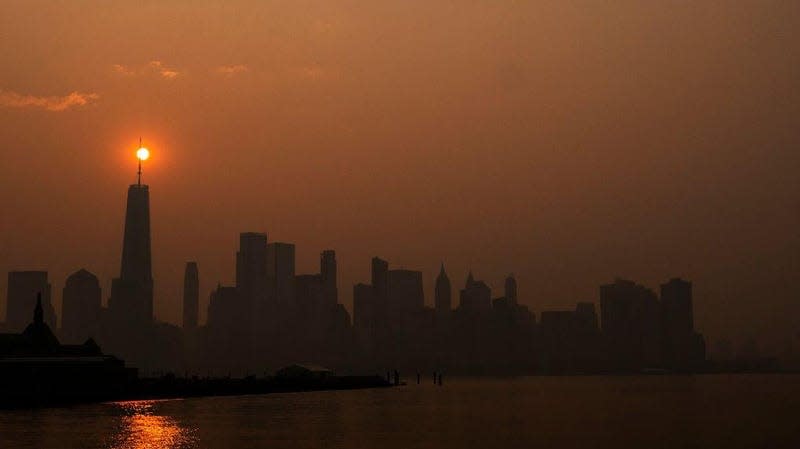Here’s What Health Experts Want You to Know About This Week’s Wildfire Smoke

There are hundreds of fires burning throughout Canada this week. The flames have burned millions of hectares, and the resulting smoke has polluted the air quality throughout the United States. Tens of millions of Americans were under air quality alerts this week as a blanket of smoke traveled south.
Red alerts were issued for air quality throughout the Midwest and the Northeast. Residents living in multiple states could smell smoke, and skylines in East Coast cities were colored bright orange. A lot of the Northwest, Mid-Atlantic, and Midwest looked like California’s skies did in 2020. Public health professionals warned residents throughout the Northern U.S. to close their windows and avoid going outside.
Read more
Check out this almost unbelievable time-lapse of wildfire smoke consuming the World Trade Center and the New York City skyline.
Those vulnerable to poor air quality, including seniors and young children, should limit time outdoors if possible.
More: https://t.co/ChRuWv7X6E pic.twitter.com/mtKtLun8lN— NWS New York NY (@NWSNewYorkNY) June 7, 2023
Two days later, much of the smoke throughout the region has cleared up, but some health experts want residents to stay informed and prepare for future events.
Peter DeCarlo, an associate professor of environmental health at Johns Hopkins University, told Earther that this week was an extreme event. But as climate change fuels more wildfires, more of the U.S. may have to prepare for smoke exposure. And seeing as Canada is battling more than 400 fires, the Northern U.S. could see more wildfire-related air pollution this summer.
“The question that I’ve had a few times is, ‘is this going to become more common’,” DeCarlo said. “It’s likely to become more common. Climate change is warming the planet and creating conditions that are more ripe for wildfires, this is a pretty early start to the wildfire season.”
Kent Pinkerton, an air pollution expert and professor at the University of California Davis, told Earther that officials had cause for worry. Wildfire smoke contains particulate matter or PM2.5. It’s tiny particles of pollution that come from different sources, including burning material. These particles are really small and can be inhaled into the lungs. Researchers have linked long-term exposure to lung problems, heart disease, and cancer.
The extremely high concentrations of smoke over the mid-Atlantic, Midwest, and Northeast aren’t just dangerous for people with already existing health issues, but for the general public. Pinkerton emphasized that anyone who may have been outside for several hours should monitor their health for the rest of this week.

“If you’re short of breath, and you’re not recovering from that…and any kind of chest pain or a rapid heartbeat should also be taken seriously,” Pinkerton said. “Check in with a medical emergency room or urgent care. I don’t think we can be too cautious.”
Even though the Northeast isn’t experiencing the orange glow from Wednesday afternoon, the East Coast and Midwest are still seeing a lot of air pollution. According to the Environmental Protection Agency’s AirNow website, the air quality in New York City, Philadelphia, and Jersey City was in the unhealthy range as of Thursday afternoon. A lot of the air pollution has thankfully cleared as of Friday morning, according to AirNow.
DeCarlo warned residents in areas with lingering smoke to avoid spending long periods outside until the air has cleared. “At the end of the day you can’t un-expose yourself,” he said. “If someone went out and took a long run, they’re going to be breathing a pretty large amount of particulate matter. That’s just not going to go away from their body anytime soon.”
Want more climate and environment stories? Check out Earther’s guides to decarbonizing your home, divesting from fossil fuels, packing a disaster go bag, and overcoming climate dread. And don’t miss our coverage of the latest IPCC climate report, the future of carbon dioxide removal, and the un-greenwashed facts on bioplastics and plastic recycling.
More from Gizmodo
Sign up for Gizmodo's Newsletter. For the latest news, Facebook, Twitter and Instagram.

